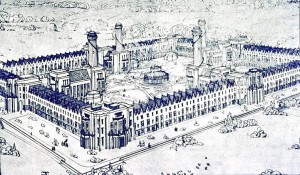 Relevant History welcomes Steve Wiegenstein, author of Slant of Light, published in 2012, and This Old World, its sequel, published in 2014. Steve grew up in the Missouri Ozarks, the setting for his novel series, and worked there as a newspaper reporter before entering the field of higher education. He is an avid hiker and canoeist who hits the trails and float streams of the Ozarks every chance he gets. Steve lives in Columbia, Missouri, but loves to speak at libraries, civic organizations, and other groups across the country. His books are available from major retailers and his publisher. To learn more about Steve’s books, check out his web site and blog. Follow him on Facebook and Twitter.
Relevant History welcomes Steve Wiegenstein, author of Slant of Light, published in 2012, and This Old World, its sequel, published in 2014. Steve grew up in the Missouri Ozarks, the setting for his novel series, and worked there as a newspaper reporter before entering the field of higher education. He is an avid hiker and canoeist who hits the trails and float streams of the Ozarks every chance he gets. Steve lives in Columbia, Missouri, but loves to speak at libraries, civic organizations, and other groups across the country. His books are available from major retailers and his publisher. To learn more about Steve’s books, check out his web site and blog. Follow him on Facebook and Twitter.
*****
Life is pretty much a mess, most of the time. People don’t behave as they should; they follow their own interests and desires, bringing them into disagreement with others and creating unnecessary heartache and conflict. Wouldn’t it be nice if everyone could agree in advance that they would act for the common good, setting aside their own wishes in favor of what’s best for everyone?
That is the essence of the Utopian ideal, and that’s why it has fascinated me for many years. I first got interested in Utopian movements when I read about the Icarians, a little-known group that lived in the United States for about fifty years in the Nineteenth Century. That interest led to a wider appreciation for the entire Utopian movement, which was a transatlantic movement inspired both by Romanticism and by the newly created idea of “social science,” both of which contributed important elements to the movement in varying degrees.
The Founding Thinkers
 When I think of the foundations of this movement, three names come to mind: Pierre-Joseph Proudhon, coiner of the memorable phrase “Property is theft”; Charles Fourier, the Utopian socialist whose concept of the “phalanx” inspired communities on both sides of the Atlantic; and Robert Owen, the Welsh reformer who put his ideas into action in Britain and the United States. The intellectual roots don’t attract me as much as the human drama, though.
When I think of the foundations of this movement, three names come to mind: Pierre-Joseph Proudhon, coiner of the memorable phrase “Property is theft”; Charles Fourier, the Utopian socialist whose concept of the “phalanx” inspired communities on both sides of the Atlantic; and Robert Owen, the Welsh reformer who put his ideas into action in Britain and the United States. The intellectual roots don’t attract me as much as the human drama, though.
The Icarians, like a lot of Utopian groups, originated with a charismatic leader who attracted a group of followers. But the Icarian movement was different from most others as well. For one thing, its founder, Etienne Cabet, hadn’t actually intended to form a settlement. He wrote a novel, Voyage to Icaria, largely to comment on the political situation in France and to keep his name in front of the French public while he served a period of exile. But the novel, in which he set forth his communistic ideas in the form of an imaginary community in the South Seas, caught the public imagination, and in 1848 Cabet found himself leading a group of immigrants to the United States to establish a real-life Icaria. The experiment was marked by equal amounts of strife and heroism, nobility and pettiness, but the last colony of Icarians didn’t disband until 1898, and their dogged persistence in trying to live out their ideal deserves our admiration, if not imitation.
The Fictional Appeal
Those of you who have read my first novel, Slant of Light, will recognize that situation as the starting premise of the book—a charismatic social reformer who founds a community, almost by accident. I depart from history at that point, but certainly one of the central themes of my book is the Utopian impulse that lives in us all, and whether that impulse can ever be realized. This Old World picks up that story after the devastation of the American Civil War, when the first wave of Utopianism died down as dreams of a radical refashioning of human nature felt to most Americans more like a cruel hoax than an achievable ideal.
Somewhere below the surface, the Utopian impulse has a dictatorial side—it’s the “I know best” impulse, the belief that life’s messes and strife could be avoided if only you would agree to what I know is best for us all. You can see hints of this impulse in the obsessive fascination with order that characterizes many of the Utopian theorists’ visions of the ideal community. Fourier’s ideal phalanx was to have 1,620 people, equally divided among male and female, and encompassing what he imagined to be all combinations of the common passions of humanity. To the social reformer, our human imperfections are a problem to be solved. But to the novelist, they’re what makes us so interesting.
The fictional inhabitants of Daybreak, the name of my fictional community in Slant of Light and This Old World, try earnestly to arrange their lives for the common good. They hold weekly meetings to vote on everything from whether to install windows in their cabins to whether to buy cloth for mourning dresses. They eat together, work together, travel together. But their communal urges keep getting thwarted by their human desires. They envy, they betray, they fall in love with the wrong people. It’s the struggle between these two sides of human nature—the desire to improve and perfect ourselves, and the desire to have what we want when we want it, regardless of others—that drew me to the Utopian experience of the Nineteenth Century as a microcosm of human nature.
*****
 A big thanks to Steve Wiegenstein. He’ll give away a Slant of Light coffee mug to someone who contributes a comment on my blog this week. I’ll choose the winner from among those who comment by Friday at 6 p.m. ET. Delivery is available worldwide.
A big thanks to Steve Wiegenstein. He’ll give away a Slant of Light coffee mug to someone who contributes a comment on my blog this week. I’ll choose the winner from among those who comment by Friday at 6 p.m. ET. Delivery is available worldwide.
**********
Did you like what you read? Learn about downloads, discounts, and special offers from Relevant History authors and Suzanne Adair. Subscribe to Suzanne’s free newsletter.

Thanks for an excellent article, Steve. What is the typical lifespan of these settlements? Do you know which utopian colony lasted longest (is it us? Certainly, there are utopian yearnings evident in the US Constitution)? They all seem to founder on the realities of human nature, their utopian ideals subverted by biological imperative and self-interest. I’ve visited Shakertown, TN, and read about East Wind in the Ozarks (thanks, Nat’l Geographic) and Tobar, NV–looking forward to reading more of your work.
Quinn, most of these settlements only lasted as long as their founder’s life. It was a rare community that persisted past the first generation. The Icarians’ fifty-year span was unusual in that respect, as their founder died in 1856, only eight years after their arrival in the U.S., but the colonies lived on another forty-plus years. Depending on how you define “utopian community,” I think you’d have to count the Shakers at Sabbathday Lake in Maine as the longest-lasting, running from 1783 to the present day. Some of the communities that were originally founded as “hippie communes” in the 1960s are still going strong, too, so they are topping fifty years at this point.
I loved Slant of Light and This Old World! I hope Steve is planning another installment of the series…
I sure am, Rachel! Working on it furiously….hope to have it finished soon.
I have been fascinated with Utopian Societies since taken a course on Spiritualism in college. Antebellum America was obsessed with the idea. I wonder what it says about us, as a society, that we are now more obsessed with dystopia?
That’s a great observation, and I wonder that too. If literature is a reflection of the mood of the age, I guess I’d have to say that the utopian ideals of the 19th century reflected an optimism that social forces could be brought under control and harnessed for the betterment of humanity, while today’s focus on a dystopian future reveals a deep unease about our ability to keep the powerful in check and a sense that people are inherently selfish and untrustworthy. Not a very pleasant reflection, but there it is. In This Old World the characters (like the rest of America) are profoundly disillusioned by the experience of the Civil War, and there’s a sense that the confident optimism of the antebellum era can never be recovered. But the country goes in cycles, and we’ve seen similar phases of disillusionment and optimism since. So maybe we’ll climb out of our current dystopianism and see more hopeful literature one day! Who knows?
Steve, I’m adding your books to my TBR list. I’m reminded of Benjamin Capps’ novel The Brothers of Uterica, about a utopian settlement in East Texas in the mid-1900s. One of the human desires that got the Utericans in trouble was the desire to stop working–turning land for planting–and wandering off to see what was going on elsewhere. Perhaps that comes down to the desire to live one’s ideals without understanding that the natural world imposes its own realities. Even idealists have to eat.
Thanks, Kathy! I have not read The Brothers of Uterica but will look it up. The tension between idealism and reality is part and parcel of American literature almost everywhere I look . . . Quinn, who commented earlier, mentioned that the United States itself is something of a utopian vision, and I think that’s very true.
Utopian societies are fascinating, especially to those who’ve studied a little sociology and enjoy observing group behavior and relationships between individuals and groups. Knowing humans, I can’t even imagine such a community lasting for longer than a few years without breaking down.
Enjoyed this post a lot, Steve. By the way, my family used to vacation in the Missouri Ozarks when I was a kid. I have wonderful memories of the fishing camps we stayed at in the Camdenton/Bagnell Dam area.
Appreciate the comment, Patricia. If you’re interested in a nonfiction history of the area where you used to vacation, I’d recommend Leland and Crystal Payton’s Damming the Osage.
Thank you, I’ll check it out. It’s a beautiful part of the country and well worth exploring, physically and historically.